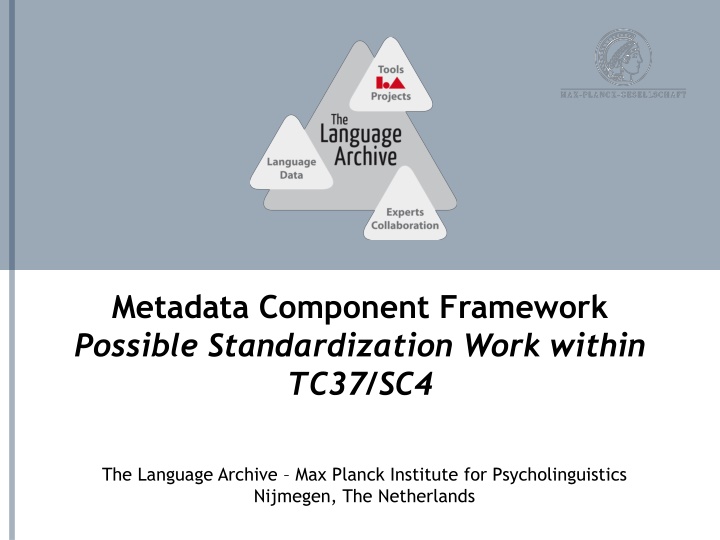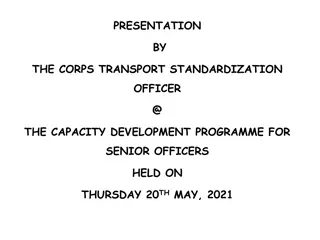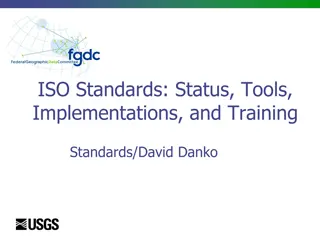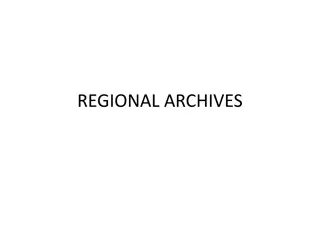Standardization Process for Metadata Components in Language Archives
The standardization process for metadata components within TC37/SC4 at the Language Archive Max Planck Institute involves analyzing existing metadata sets, seeking input from the CLARIN EU community, and determining the next steps for standardization. The process includes forming submission groups, selecting data categories, making decisions on submitted components, and validating for publication. The aim is to address limitations in existing metadata schemas and enhance support for linguistic tool and service descriptions.
Download Presentation

Please find below an Image/Link to download the presentation.
The content on the website is provided AS IS for your information and personal use only. It may not be sold, licensed, or shared on other websites without obtaining consent from the author.If you encounter any issues during the download, it is possible that the publisher has removed the file from their server.
You are allowed to download the files provided on this website for personal or commercial use, subject to the condition that they are used lawfully. All files are the property of their respective owners.
The content on the website is provided AS IS for your information and personal use only. It may not be sold, licensed, or shared on other websites without obtaining consent from the author.
E N D
Presentation Transcript
Metadata Component Framework Possible Standardization Work within TC37/SC4 The Language Archive Max Planck Institute for Psycholinguistics Nijmegen, The Netherlands
Status of ISOCat Metadata Thematic Domain Based on extensive discussions with experts (Athens, ) Analysing existing metadata sets & inventories: OLAC, IMDI, ENABLER, Input from CLARIN EU community that also provided translations Dedicated CLARIN NL metadata project Currently 220 metadata DCs
Further steps Time to take stock of the situation How to proceed with standardization? Metadata TDG chair proposal is: Today walk through the current set of metadata DCs and take note of all comments Start round two, contact all previous contributors (incl. those that were active providing translations) After Christmas, the TDG will take charge again ISOCat supported standardization procedures are in place, but is this sufficient? TDG members representative enough? DCs ownership not completely transparent Maybe just startup problems or
Standardization process Create submission group , collection of DC owners Create (one or more coherent) DC selection(s) After submission, the TDG chair forms a decision group {chair, at least one other member} Decision group decides on all submitted DCs This is further forwarded to the DCR board DCR board has to validate and bring to publication
DCR Decision process Decision Group Submission group Thematic Domain Group Data Category Registry Board Stewardship group Evaluation Validation rejected rejected Publication
Standardization & Metadata Components Assumption is that there is broad agreement about limitations existing metadata schemas: DC/OLAC, IMDI, TEI header Inflexible: too many (IMDI) or too few (OLAC) metadata elements Limited interoperability (both semantic and syntactic) Problematic (unfamiliar) terminology for some sub- communities. Limited support for LT tool & services descriptions Address this by: Explicit defined schema & semantics User/project/community defined components
Metadata Components NOT a single new metadata schema but rather allow coexistence of many (community/researcher) defined schemas with explicit semantics for interoperability How does this work? Components are bundles of related metadata elements that describe an aspect of the resource A complete description of a resource may require several components. Components may contain other components Components should be designed for reusability
Metadata Components Lets describe a speech recording Sample frequency Format Size Technical Metadata
Metadata Components Lets describe a speech recording Name Language Id Technical Metadata
Metadata Components Lets describe a speech recording Name Actor Age Sex Language Language Technical Metadata
Metadata Components Lets describe a speech recording Continent Country Address Location Actor Language Technical Metadata
Metadata Components Name Project Lets describe a speech recording Contact Location Actor Language Technical Metadata
Metadata Components Project Lets describe a speech recording Location Profile definition XML Actor Metadata schema W3C XML Schema Language Technical Metadata Component definition XML Metadata description XML File Metadata profile
Recursive Project Recursive Component model Components can contain other components Enhances reusability Location Actor ActorLanguage Address
Reusability & Explicit Semantics Component registry User selects appropriate components to create a new metadata profile or selects an existing profile Location Country Coordinates Text Language Title user Semantic interoperability partly solved via references to ISO DCR or other registry Actor BirthDate MotherTongue ISOCat or ISO DCR implementation of ISO-12620 standard for data categories under control of the linguistic community ISO TC37 Metadata is just one of the seven thematic domains Recording CreationDate Type Dance Country dcr:1001 Language dcr:1002 BirthDate dcr:1000 ISOcat concept registry Name Type DCMI concept registry Title: dc:title Selecting metadata components & profiles from the registry
How to proceed? Decouple separate issues? Standardization of metadata DCs in the ISO-DCR ------------------------------------------------------------------ Defining Requirements for a Metadata Component Model Standardizing the Component Model itself Standardizing a Component Specification Language Design/Specify a number of recommended components for specific data types and usages. Of course building on existing or continuing work like ISOCat, PISA, where possible
Requirements for the component model For example: Component has attributes: name, multiplicity, concept- link, Component model should support recursion A component contains a number of metadata elements A metadata element has a: name, value-scheme, multiplicity, concept link A component can refer to a number of resources or to other metadata components A component can contain information about resource relations A component grammar has to be fully deterministic to avoid ambiguity
Metadata Component Model Should embody the requirements without defining a component specification language As an example the CLARIN CMDI component model
Component Specification Language CLARIN Component example: ISO-635 component <CMD_ComponentSpec isProfile="false"> <Header> <ID>clarin.eu:cr1:c_1271859438108</ID> <Name>iso-639-5</Name> <Description>The list of ISO-639-5 language families. Based on: http://en.wikipedia.org/wiki/List_of_ISO_639-5_codes</Description> </Header> <CMD_Component name="ISO635"> <CMD_Element CardinalityMax="unbounded" CardinalityMin="1" name="iso-639-5- code"> <ValueScheme> <enumeration> <item AppInfo="Austro-Asiatic languages" ConceptLink="http://cdb.iso.org/lg/CDB- 00138763-001">aav</item> <item AppInfo="Afro-Asiatic languages" ConceptLink="http://cdb.iso.org/lg/CDB- 00138759-001">afa</item> <item AppInfo="Algonquian languages" ConceptLink="http://cdb.iso.org/lg/CDB- 00138721-001">alg</item> <item AppInfo="Atlantic-Congo languages" ConceptLink="http://cdb.iso.org/lg/CDB- 00138719-001">alv</item> [...]
ISO Recommended Components Our CMDI experience is that we need to limit the proliferation of components Offer a set of standardized ones for use with specific data-types for specific purposes
Reference implementation CLARIN has been working on: Metadata component registry and editor Metadata editor If a potential ISO standard for component model and specification is not too different from CLARIN requirements and practice these could serve as a reference implementation
Persistent Identifier Use All is based on the recent FDIS-24619 PISA Cool URIs for the concept links to ISOCat and ISOCDB All references to resources and metadata can contain PIDs
Thank you for your attention The Language Archive Max Planck Institute for Psycholinguistics Nijmegen, The Netherlands























